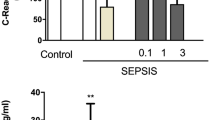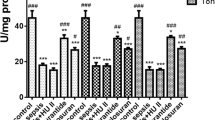Abstract
Dextromethorphan (DM), an antitussive agent, has been claimed to have anti-inflammatory and immunomodulatory effects in vitro. Thus, the aim of this study was to evaluate the effects of DM on sepsis induced by intravenous (i.v.) administration of lipopolysaccharide (LPS) in anesthetized Wistar rats and by intraperitoneal administration in conscious ICR mice. Results demonstrated that pretreatment with DM (1,5 and 10 mg/kg, i.v.) significantly attenuated the deleterious hemodynamic changes (e.g., hypotension and tachycardia) in rats treated with LPS. Meanwhile, DM (5 mg/kg) significantly inhibited the elevation of plasma tumor necrosis factor-α and interleukin-10 levels, as well as values of GOT and GPT (as an index of liver function), and BUN and creatinine (as an index of renal function) caused by LPS. The induction of inducible NO synthase and the overproduction of NO and superoxide anions by LPS were also reduced by DM. Moreover, infiltration of neutrophils into the lungs and liver of rats 6 h after treatment with LPS was also reduced by DM. In conclusion, the beneficial effects of DM on LPS-induced sepsis result from its anti-inflammatory and antioxidant effects. Thus, DM can possibly be used as a prophylactic agent for sepsis in the future.
Similar content being viewed by others
References
Beckman JS, Beckman TW, Chen J, Marshall PA, Freeman BA. Apparent hydroxyl radical production by peroxynitrite: Implications for endothelial injury from nitric oxide and superoxide. Proc Natl Acad Sci USA 87:1620–1624;1990.
Benigni F, Villa P, Demitri MT, Sacco S, Sipe JD, Lagunowich L, Panayotatos N, Ghezzi P. Ciliary neurotrophic factor inhibits brain and peripheral tumor necrosis factor production and, when coadministered with its soluble receptor, protects mice from lipopolysaccharide toxicity. Mol Med 1:568–575;1995.
Bone RC. Systemic inflammatory response syndrome: A unifying concept of systemic inflammation. In: Fein AM, Abraham EM, Balk RA, Bernard GR, Bone RC, Dantzker DR, Fink MP, eds. Sepsis and Multiorgan Failure. Pennsylvania, Williams & Wilkins, 3–10;1997.
Callery MP, Kamei T, Mangino MJ, Flye MW. Organ interactions in sepsis. Host defense and the hepatic-pulmonary macrophage axis. Arch Surg 126:28–32;1991.
Choi DW. Dextrorphan and dextromethorphan attenuate glutamate neurotoxicity. Brain Res 403:333–336;1987.
Craviso GL, Musacchio JM. High-affinity dextromethorphan binding sites in guinea pig brain. I. Initial characterization. Mol Pharmacol 23:619–628;1983.
Craviso GL, Musacchio JM. High-affinity dextromethorphan binding sites in guinea pig brain. II. Competition experiments. Mol Pharmacol 23:629–640;1983.
de Waal MR, Abrams J, Bennett B, Figdor CG, de Vries JE. Interleukin 10 (IL-10) inhibits cytokine synthesis by human monocytes: An autoregulatory role of IL-10 produced by monocytes. J Exp Med 174:1209–1220;1991.
Deitch EA. Multiple organ failure. Pathophysiology and potential future therapy. Ann Surg 216:117–134;1992.
Fiorentino DF, Zlotnik A, Mosmann TR, Howard M, O'Garra A. IL-10 inhibits cytokine production by activated macrophages. J Immunol 147:3815–3822;1991.
Gerard C, Bruyns C, Marchant A, Abramowicz D, Vandenabeele P, Delvaux A, Fiers W, Goldman M, Velu T. Interleukin 10 reduces the release of tumor necrosis factor and prevents lethality in experimental endotoxemia. J Exp Med 177:547–550;1993.
Haberecht MF, Mitchell CK, Lo GJ, Redburn DA. N-Methyl-D-aspartate-mediated glutamate toxicity in the developing rabbit retina. J Neurosci Res 47:416–426;1997.
Horn KD. Evolving strategies in the treatment of sepsis and systemic inflammatory response syndrome (SIRS). QJM 91:265–277;1998.
Howard M, Muchamuel T, Andrade S, Menon S. Interleukin 10 protects mice from lethal endotoxemia. J Exp Med 177:1205–1208;1993.
Jansen MJ, Hendriks T, Vogels MT, van der Meer JW, Goris RJ. Inflammatory cytokines in an experimental model for the multiple organ dysfunction syndrome. Crit Care Med 24:1196–1202;1996.
Jiang H, Stewart CA, Leu RW. Tumor-derived factor synergizes with IFN-gamma and LPS, IL-2 or TNF-alpha to promote macrophage synthesis of TNF-alpha and TNF receptors for autocrine induction of nitric oxide synthase and enhanced nitric oxide-mediated tumor cytotoxicity. Immunobiology 192:321–342;1995.
Khadour FH, Panas D, Ferdinandy P, Schulze C, Csont T, Lalu MM, Wildhirt SM, Schulz R. Enhanced NO and superoxide generation in dysfunctional hearts from endotoxemic rats. Am J Physiol 283:H1108-H1115;2002.
Kikkawa I, Saito S, Tominaga K, Hoshino Y, Ooi Y, Nakano M. Lipopolysaccharide (LPS) stimulates the production of tumor necrosis factor (TNF)-alpha and expression of inducible nitric oxide synthase (iNOS) by osteoclasts (OCL) in murine bone marrow cell culture. Microbiol Immunol 42:591–598;1998.
Kukreja RC, Hess ML. The oxygen free radical system: From equations through membrane-protein interactions to cardiovascular injury and protection. Cardiovasc Res 26:641–655;1992.
Lipton SA. Prospects for clinically tolerated NMDA antagonists: Open-channel blockers and alternative redox states of nitric oxide. Trends Neurosci 16:527–532;1993.
Liu Y, Qin L, Li G, Zhang W, An L, Liu B, Hong JS. Dextromethorphan protects dopaminergic neurons against inflammation-mediated degeneration through inhibition of microglial activation. J Pharmacol Exp Ther 305:212–218;2003.
Moncada S, Palmer RM, Higgs EA. Nitric oxide: Physiology, pathophysiology, and pharmacology. Pharmacol Rev 43:109–142;1991.
Moore KW, Vieira P, Fiorentino DF, Trounstine ML, Khan TA, Mosmann TR. Homology of cytokine synthesis inhibitory factor (IL-10) to the Epstein-Barr virus gene BCRFI. Science 248:1230–1234;1990.
Stepaniak JA, Gould KE, Sun D, Swanborg RH. A comparative study of experimental autoimmune encephalomyelitis in Lewis and DA rats. J Immunol 155:2762–2769;1995.
Sugino K, Dohi K, Yamada K, Kawasaki T. Changes in the levels of endogenous antioxidants in the liver of mice with experimental endotoxemia and the protective effects of the antioxidants. Surgery 105:200–206;1989.
Sugino K, Dohi K, Yamada K, Kawasaki T. The role of lipid peroxidation in endotoxin-induced hepatic damage and the protective effect of antioxidants. Surgery 101:746–752;1987.
Szabo C, Salzman AL, Ischiropoulos H. Endotoxin triggers the expression of an inducible isoform of nitric oxide synthase and the formation of peroxynitrite in the rat aorta in vivo. FEBS Lett 363:235–238;1995.
Szabo C, Wu CC, Gross SS, Thiemermann C, Vane JR. Interleukin-1 contributes to the induction of nitric oxide synthase by endotoxin in vivo. Eur J Pharmacol 250:157–160;1993.
Takemura R, Werb Z. Secretory products of macrophages and their physiological functions. Am J Physiol 246:C1-C9;1984.
Thiemermann C, Ruetten H, Wu CC, Vane JR. The multiple organ dysfunction syndrome caused by endotoxin in the rat: Attenuation of liver dysfunction by inhibitors of nitric oxide synthase. Br J Pharmacol 116:2845–2851;1995.
Thiemermann C, Wu CC, Szabo C, Perretti M, Vane JR. Role of tumour necrosis factor in the induction of nitric oxide synthase in a rat model of endotoxin shock. Br J Pharmacol 110:177–182;1993.
Thiemermann C. The role of theL-arginine: Nitric oxide pathway in circulatory shock. Adv Pharmacol 28:45–79;1994.
Tortella FC, Pellicano M, Bowery NG. Dextromethorphan and neuromodulation: Old drug coughs up new activities. Trends Pharmacol Sci 10:501–507;1989.
Tracey KJ, Cerami A. Tumor necrosis factor, other cytokines and disease. Annu Rev Cell Biol 9:317–343;1993.
Wu CC, Chen SJ, Szabo C, Thiemermann C, Vane JR. Aminoguanidine attenuates the delayed circulatory failure and improves survival in rodent models of endotoxic shock. Br J Pharmacol 114:1666–1672;1995.
Wu CC, Chiao CW, Hsiao G, Chen A, Yen MH. Melatonin prevents endotoxin-induced circulatory failure in rats. J Pineal Res 30:147–156;2001.
Wu CC, Liao MH, Chen SJ, Chou TC, Chen A, Yen MH. Terbutaline prevents circulatory failure and mitigates mortality in rodents with endotoxemia. Shock 14:60–67;2000.
Wu CC, Ruetten H, Thiemermann C. Comparison of the effects of aminoguanidine and N omega-nitro-L-arginine methyl ester on the multiple organ dysfunction caused by endotoxaemia in the rat. Eur J Pharmacol 300:99–104;1996.
Wu CC, Croxtall JD, Perretti M, Bryant CE, Thiemermann C, Flower RJ, Vane JR. Lipocortin 1 mediates the inhibition by dexamethasone of the induction by endotoxin of nitric oxide synthase in the rat. Proc Natl Acad Sci USA 92:3473–3477;1995.
Xie YW, Wolin MS. Role of nitric oxide and its interaction with superoxide in the suppression of cardiac muscle mitochondrial respiration. Involvement in response to hypoxia/reoxygenation. Circulation 94:2580–2586;1996.
Yamano M, Umeda M, Miyata K, Yamada T. Protective effects of a PAF receptor antagonist and a neutrophil elastase inhibitor on multiple organ failure induced by cerulein plus lipopolysaccharide in rats. Naunyn Schmiedebergs Arch Pharmacol 358:253–263;1998.
Yang F, Comtois AS, Fang L, Hartman NG, Blaise G. Nitric oxide-derived nitrate anion contributes to endotoxic shock and multiple organ injury/dysfunction. Crit Care Med 30:650–657;2002.
Author information
Authors and Affiliations
Rights and permissions
About this article
Cite this article
Wang, CC., Lee, YM., Wei, HP. et al. Dextromethorphan prevents circulatory failure in rats with endotoxemia. J Biomed Sci 11, 739–747 (2004). https://doi.org/10.1007/BF02254358
Received:
Accepted:
Issue Date:
DOI: https://doi.org/10.1007/BF02254358




